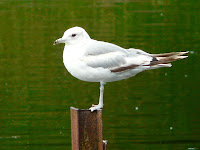I was continuing my Great Crested Newt translocation project at Cottam and was surprised by the amount of calling Chiffchaff's on the site (as well as a Tree Pipit and plenty of Meadow Pipits) there had obviously been a decent fall of migrants last night. Within the Chiffchaffs I picked out the distinctive call of a Yellow-Browed Warbler, a classic Autumn migrant which is turning up everywhere at the moment, it eventually flitted across the canal on to the University of Central Lancashire's athletics ground, I am next in the area on Thursday, maybe it will stick around. There is also one showing well at Leasowe, Wirral today. No Great Crested Newts today but Smooth Newts and a Bank Vole in a pitfall trap!
After the Newt work I headed for Horwich and the four juvenile Glossy Ibises that have been seen intermittently for the last few days. I couldn't believe how close they allow birders to approach them (see the photo and mobile phone video upload), these birds have no doubt been pushed to the UK by the recent Eastern winds that also result in the appearance of Yellow-Browed Warblers. As I left the site at 11:20 they flew over the road and out of sight, but no doubt are still in the area and well worth a visit! I then took the opportunity to catch up with the female Black Redstart that has been seen nearby for the last couple of weeks, with time pressing I only managed brief views of the bird, yet it did show off a bit; fly catching off the dry stone walls on the edge of the moorland.



















































